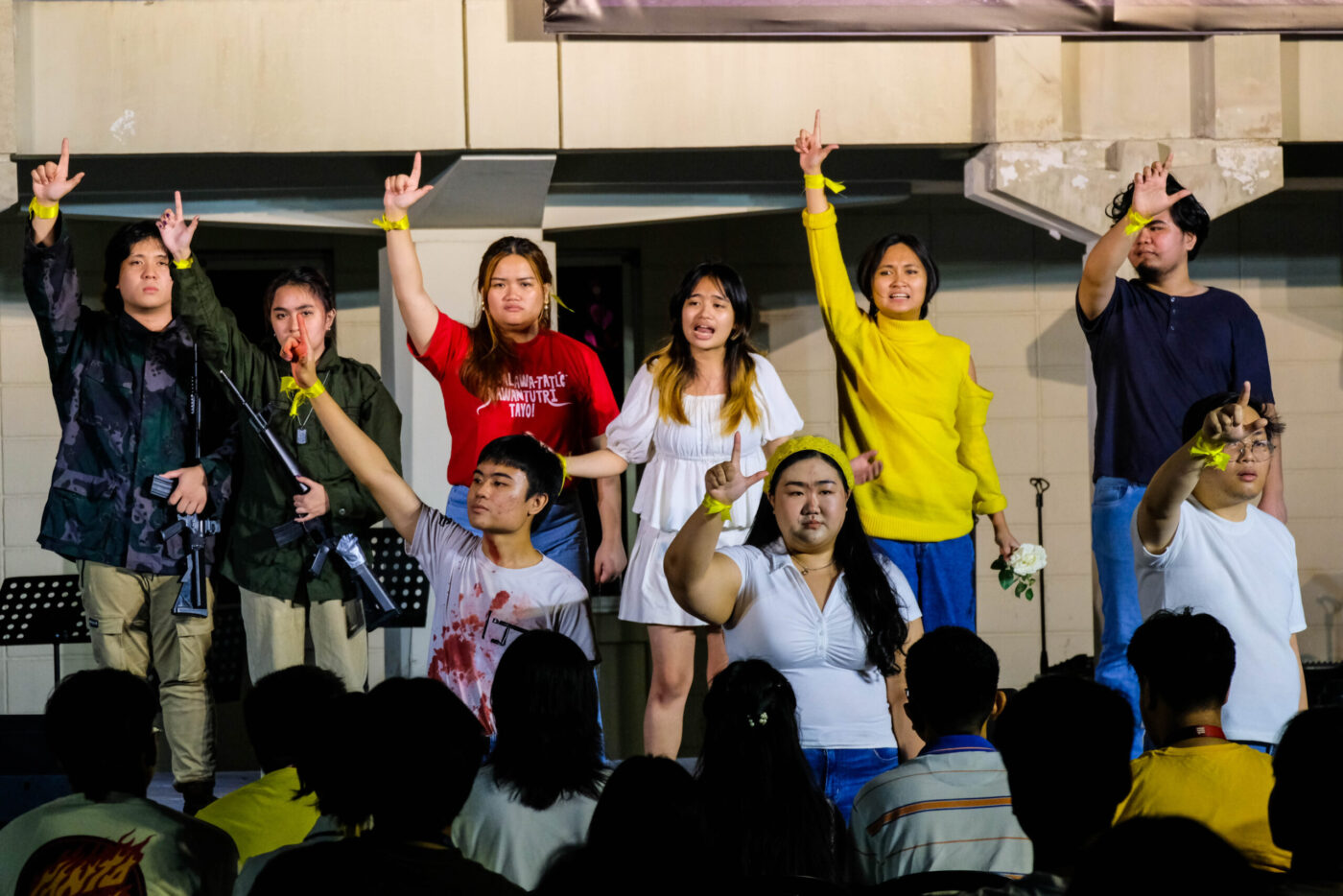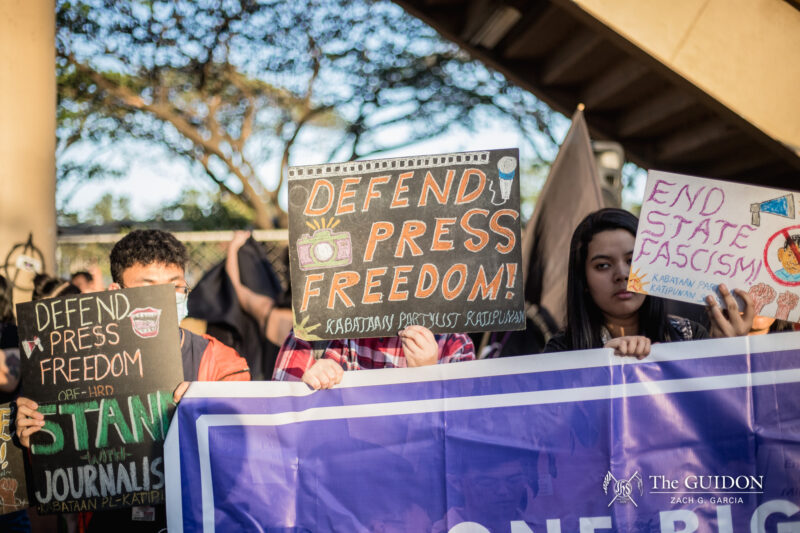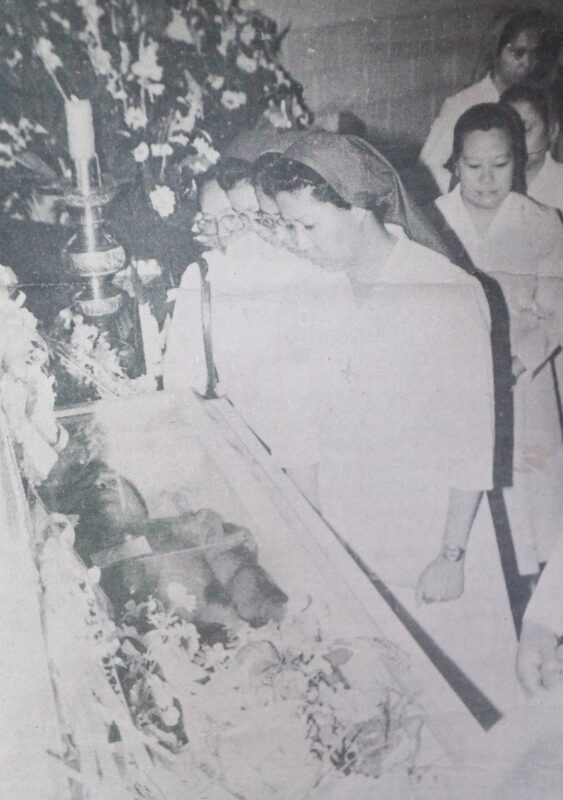Editor’s Note: The following article is taken from The GUIDON Volume 54, Number 6, originally published March 1987.
TO A martial law baby, what happened in 1972 was part of a past that was never his; he did not understand what Martial Law meant, he did not experience what Martial Law created and suppressed. All he ever experienced and understood during that time was the world of tales, fantasy, and Lola Basyang.
In addition to [the] experience of all Atenean Martial Law babies, we present a tale: the twelve days before September 22, 1972, the time of the reign of Mr. Klean, and what it all meant to those who lived in it. It is but fair to note that no one [needs to] read this tale for such stories seem to have an amazing ability to render a repeat performance.
Without any dramatic ceremony, let the tale begin…
Not so long ago, there was this dedicated man who was determined to clean his nation of its evil; he intended to bring peace to the islands, even if he had to kill every troublemaker to do it. He soon discovered that to rinse out the bad and rub in the beautiful, he would have to commission his military units to wash out all contaminating parties that subvert the ideals of the nation. Let us call this dedicated chief of the cleaning crusade, Mr. Klean. And his country: Martial Laundry.I
‘Laban dito, laban doon, Kay Mr. Klean, power plus 2…’ The scene: A classroom in Ateneo, October 27, 1972. Enter an Atenean. A typical [teenager] of the seventies. Long hair, psychedelic shirt, flared pants, leather shoes with 1-inch-high heels. He glances furtively around, making sure that no eyes see what they are not supposed to see. He then cautiously brings out, from under his shirt, four worn mimeographed pages of what is known among the activists as the Rebel Pandayan. It is the underground newspaper of the Ateneans, stemming from the Pandayan, the once official newspaper of the Ateneo (along [The GUIDON]), that was abruptly extinguished due to the friction between the college Dean and what he called the “irresponsible journalism” manifested in the Pandayan.
The Atenean gently leafs through the pages. He knows that there are only 12 copies circulating around the campus. He must then make sure that when he passes the Rebel Pandayan on, it must be in readable condition.
His eyes finally rest on the neat type on page 3. Little was he aware of the other eyes which were watching him from afar. The page read:
“Dear fellow citizen,
You must know by now that martial law has been declared for the entire Philippines by the Chief Executive. This declaration was contained in Proclamation 1081 which was signed on September 21, 1972 and took effect the next day.
Before we pass judgment on President Marcos’s decision, let us first examine the events and circumstances surrounding his declaration.
When he declared martial law, President Marcos cited subversion as the primary cause of our country’s economic stagnation. He stated that the bombings and disturbances immediately before his declaration had ‘paralyzed’ economic activity. He had declared martial law in order to ‘save the republic and build a new society.’
The arguments of President Marcos fall flat in his face. He cannot use subversion as the excuse for the graft and corruption in his government and for his [overall] maladministration. Besides, he never proved that the bombings were done by the New People’s Army and other ‘subversives.’ In fact, because he did impose martial law, it becomes much more logical to conclude that he himself was responsible for these disturbances so as to justify such imposition.
His ‘new society’ cannot be any different from his ‘great again society,’ his ‘democratic revolution’ nor his wife’s ‘green revolution,’ which proved to be nothing but mere pakulos designed to fool the people. For his ‘new society,’ Marcos talks of land reform, but his mansions stand on the biggest privately-owned lands in this part of the world. He talks of eradicating corruption when he has enriched himself through corruption to become the richest man in Asia… Remember the more than twenty massacres under his regime including the Plaza Miranda carnage in 1971. Can this be the man who would ‘save the republic and build a new society’?
Martial law means that the military now controls the government and assumes supreme command. In other words, it means a military dictatorship despite all claims to the contrary of the monotonous Marcos propaganda machinery. As command-in-chief of the military, Marcos formally becomes a dictator.
His mind reeled. To think that on September 10, 1972, the secretary of defense was quoted as saying that martial law is remote.
September 10. Twelve days before martial law took effect over the whole country.
It all sounded like a sad song…
II
On the twelfth day before Martial law…
…Kay Mr. Klean, tatawa ka—ha ha ha ha ha ha ha
The confident voice of a defense secretary fills the news page. Martial law? “It all depends. You will reach a point in time when you have to reach a decision and calculate the risks. You cannot make a hard and fast statement. As of now, it is remote.”
But as the days flew by, it became increasingly obvious that martial law would emerge…
The headlines scream: “WARNING: NPA-coddlers are marked for liquidation. FM warns local executives.
A revolution always devours its own children and if state officials who play footsie with insurgent communists are not careful, they are liable to share the fate of their counterparts in history.”
On the tenth day…
A mysterious explosion destroys Metro Manila Waterworks and Sewerage System (MWSS) watermains in Sta. Mesa.
And from the Man himself: “Martial law? No.” This statement makes a hit in the papers: “The options available to the President in the face of worsening rebellion are the calling out of the troops, suspension of the writ of habeas corpus, or the imposition of martial law. Following a session with the National Security Council, the President declared that he was not disposed to yield to any of these emergency powers at this state of the insurgency by the Maoist New People’s Army.”
On the ninth day…
A senator of Tarlac charged that the president has ordered a top-secret military plan to put the Greater Manila Area, 12 towns of Rizal, and the whole of Bulacan province under Philippine Constabulary control as a prelude to martial law.
On the other side, the secretary of the Department of Education and Culture issued guidelines on how to “weed out student subversives” in all the universities. Militarization had begun even before martial law had been officially declared. All students found to be in active dissent against the school administration or that of the country were to be expelled from school and not be allowed to return unless on official business.
On the eighth day…
In answer to the senator’s charges the day before, the Chief declassifies the Armed Forces of the Philippines contingency plan to a select group of Metro Manila mayors; he authorizes the AFP to show the opposition—now that security has been breached—the government contingency plan to meet the escalating government insurgency.
On the seventh day…
Terrorism is in the air as the Soriano Building in Makati is bombed.
On the sixth day…
Tension rises, the Chief charges the leaders of the Liberation Party with forged alliance with the communists in a concerted effort to overthrow the government. He accuses the LP leaders of conducting a meeting September 7, 1972, with the chairman of the Communist Party of the Philippines, Maoist Faction.
On the fifth day…
Reopening of classes in Ateneo after a suspension due to the terrorism snaking across the city, and the students were greeted by new rules and regulations that many considered a method of ensuring a “deceptively militaristic hold on all movements within the campus.”
The essence of these new rules and regulations is that “the administration takes the role of watchdog in the campus.”
The only campus organizations allowed to carry out their activities are those considered ‘safe’ by the dean—the Ateneo Catechetical Instruction League, the Ateneo Christian Life Community and Sarilikha. The Intramural Athletic Club was still allowed to function in a desperate move by the administration to appease the students and to give them a semblance of normalcy of campus life.
Ironically, even apolitical organizations like the Glee Club suffer the consequences of such a regulation. In order to push through with its plans for a concert, the Glee Club has to take pains to rehearse out of the campus.
Meanwhile, the rooms of organizations affected by the order remain closed to the students.
Ateneans were also ordered to vacate their lockers and to avoid carrying attache cases and “similar containers which can cause suspicion of containing arms, incendiary materials, etc.” to the inconvenience of the students.
“Concerted activities like rallies and pickets were strictly prohibited, thus depriving the students of effective means by which to fight any abuse on the part of the administration.
“These rules and regulations have been unilaterally formulated by the administration without student voice or even mere consultation.”
The administration employed the use of plainclothesmen for intelligence or even arrests right inside the campus.
On the fourth day…
The terrorist threat soars as another blast rocks Quezon City Hall and injures 12. This is the eleventh blast that has hit Metro Manila in a four-week period.
On the third day…
The secretary of Defense reveals that the senator of Tarlac, not the LP leaders, met with the communists in the hope of joining forces with them. In a statement released to the press, the secretary said that the senator had confided in him what transpired during the September 7 meet in Makati.
On the second day…
The senator: I deny that I met with the chairman of the CPP.
Next to his statement was the secretary of defense’s report on the matter. After expounding on the details of the meeting, the report ended with: “Although I promised the senator that I should keep the above statement in strict (sic) confidence, I feel it is my duty as Secretary of National Defense to inform you Mr. PRESIDENT (sip) about it because of the very obvious national security implication (sipsip) of the matter brought to my attention.”
On the first day:
The Executive Secretary says that the country is entering a crisis: the nation is in the grip of fear, the economy is stagnating, government machinery [is] grinding to a halt as the communist insurgency escalates into urban guerilla warfare, including terrorist bombings.
The chief signs Proclamation 1081.
September 22, 1972
The nation is officially under martial law but the press has not yet covered the story for the Chief had yet to announce the signing of Proclamation 1081 on the evening of September 23, 1972.
…Mr. Klean mahal ka namin, dulot mo’y…
III
He remembered everything. Even that one Saturday, September 23, when the people became apprehensive — everything was quiet. The morning papers did not rise with the sun as they customarily did. Most radio and television stations were silent. Reports came trickling in: air travel had been suspended. The masses flocked to the stores in the heat of panic buying. Banco Filipino, one of the few banks open on Saturdays[,] was closed because of the “uncertain” situation.
The daily papers came out the next day with martial law hitting the headlines. New regulations were announced: Departure of Filipinos for abroad — suspended, except for official missions. Rallies: prohibited. New media: placed under government control along with the Philippine Long Distance Telephone Company, Meralco, the water systems, Philippine National Railways and Philippine Airlines. Land reform will be announced. Government will be reorganized. Corrupt officials will be replaced. New rules for conduct of civil servants will be promulgated. [Freedom] becomes narrower as the list grows longer.
The press reported reassuringly (yet with dubious accuracy) that the people had taken the news calmly.
That was 33 days ago. So much [has] happened since then. Twelve Ateneans were dropped from the rolls by the Administration because of their active dissent against the [clerico-fascist] dean and the U.S.-Marcos dictatorship. Their dissent was manifested in campus mass actions and convocations, in student council decisions and in publications.
Twelve Ateneans dismissed without trial. Fifteen others placed under strict surveillance. To ensure their abstention from activism, their parents have been informed and told to watch their sons.
He continued reading the Rebel Pandayan…
Martial law also means the death of our civil liberties. [Freedom] of speech, freedom of assembly, freedom of the press, academic freedom, freedom to air grievances, freedom to dissent — all are now [suppressed]. Curfew has been imposed. Checkpoints have been established in many places and restrict free traffic. All dissenters are arrested and imprisoned with some becoming (sic) unheard of. We are at the mercy of a military known for its long tradition of abuses and for its mercenary character. Just —
He did not finish. Before him flashed the nimble figure of a student agent who rudely confiscated the rebel paper, and haughtily informed the Atenean to report to the Dean’s office for questioning on the matter.
He complied without resistance, for he knew there was no escape. That’s [what] martial law meant. No escape.
Exit: The Atenean, the student agent and freedom.







